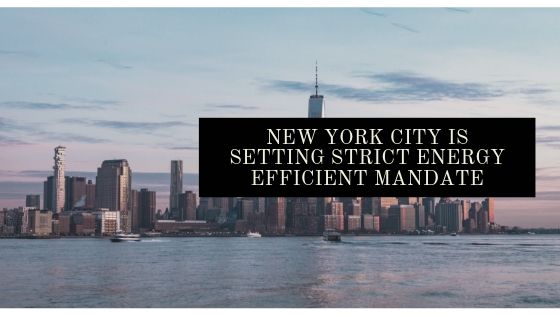Mayor Bill de Blasio recently signed an energy mandate in New York City in order to curb the negative effects of global warming. It is one of the most ambitious energy efficiency laws on record. When passed, the citywide ban will affect the city’s largest buildings and landmarks, such as the Empire State Building. The law is part of the Climate Mobilization Act, which is a broader law aimed at energy efficiency and reducing the carbon footprint of the city.
How it affects big buildings
Over eight million people live in New York City, and millions of tourists flock there each year to partake of all the “Big Apple” has to offer. Though many of the city’s buildings are dedicated to these residents, the big buildings in the city use the majority of the power. Though big buildings, defined as buildings that are over 25,000 square feet, only make up two percent of the city’s real estate, they account for over 50 percent of its energy usage.
The new law, which is the first of its kind in the country, places specific emissions limits on these larger buildings. Those who fail to meet these limits will have financial repercussions imposed by the Office of Building Energy Performance.
Not all big buildings are affected by the law, however. Houses of worship, low-income housing, and rent-regulated apartments are encouraged to be energy efficient but will not be required to meet the strict limits. Opponents of the law believe that exempting these building places too much of a burden on other big buildings.
New York State’s “Green New Deal” may help
New York State has taken the lead in the nation by pushing for energy efficiency with the “Green New Deal.” The law pushes to reduce fossil fuel consumption by residents and achieve a zero-carbon mix of energy by 2040. The state will help big buildings reduce the carbon intensity of the used energy.
Experts say that big buildings must take initiatives to become more energy efficient by installing solar panels, utilizing other methods of energy generation, doing deep energy retrofits, and buying green power.
Possibility of closing power plants
Part of the new law would direct the city to close 21 power plants that utilize natural gas within the borders. The power plants would be required to be replaced with renewable energy and energy storage facilities. Even though power plants actually create very few jobs opponents have expressed concern over the loss of jobs and the costs that will come with closing the power plants. We want to suggest to take a closer look at all the business opportunities that will arise for craftsmen, builders and even the independent handyman.
Remembering arguments from the past
We have always faced arguments by people without a clear understanding of the issue of energy efficiency. Despite incredible levels of smog and lead in the air of major cities a few decades ago, many people were radically opposed to catalytic converters in cars to be able to use unleaded fuel. They claimed it would destroy the car industry and take the fun out of driving. On the contrary, the opposite happened. Only companies which did not improve their technology failed. The industry overall has more than doubled in size since. Distributed generation is just a new technological development that will slowly but continuously replace old, large power plants.
